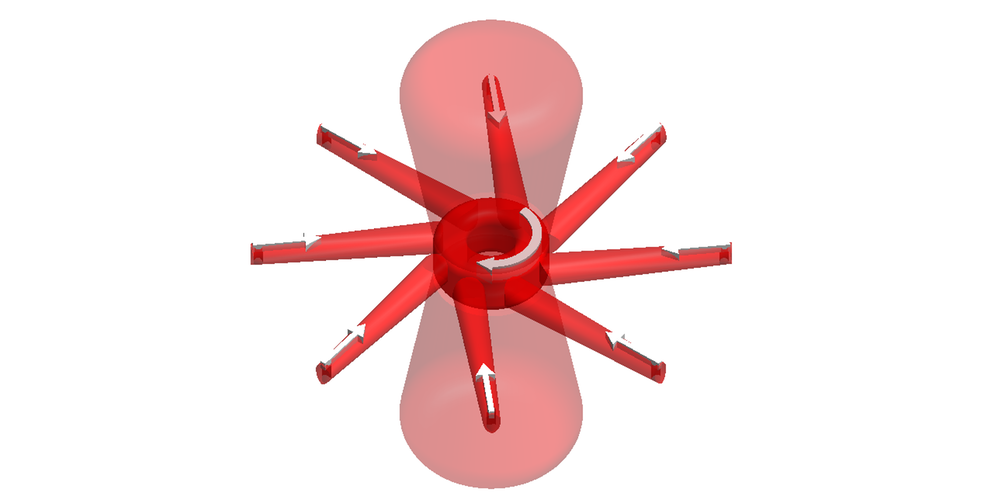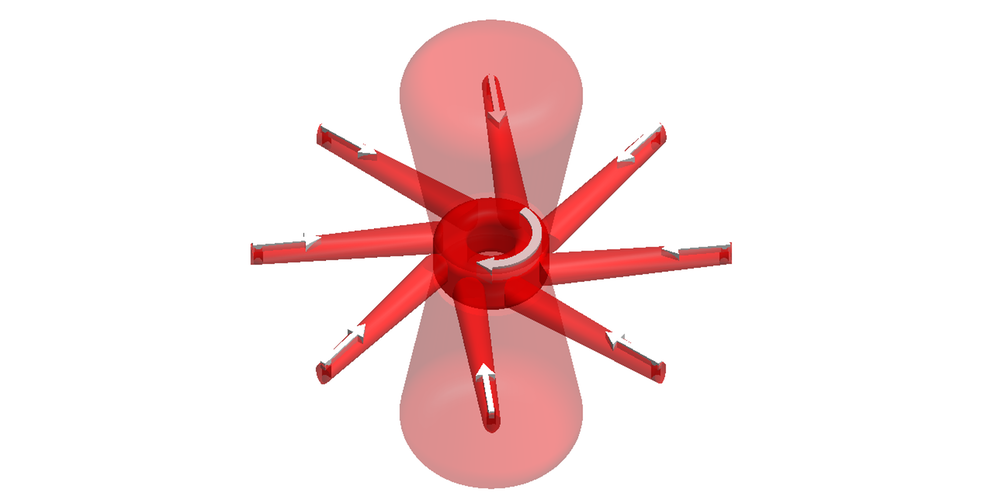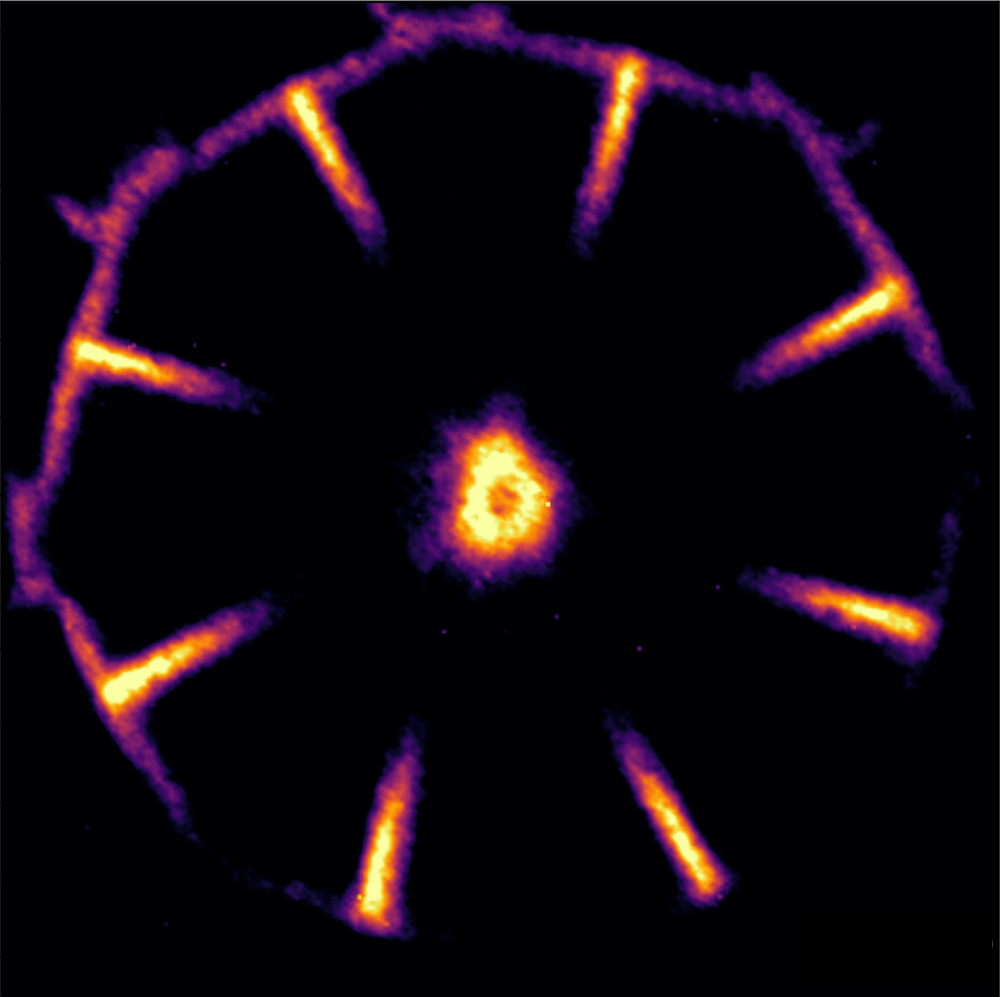A Lab Plasma Rotates and Produces Jets
Astrophysicists have many questions about the so-called accretion disk that forms from plasma and other matter falling into a black hole. Now researchers have generated a rotating ring of plasma in an unconfined arrangement in the lab, which will enable more realistic studies of plasma in astrophysical disks [1]. The lab plasma also produced a jet perpendicular to the disk, as real black holes do. The experiment could provide a platform for testing theories describing the evolution of astrophysical disks.
According to observations, the matter in a black hole accretion disk spirals inward at a rate that is thousands of times faster than would be expected from turbulence-free rotation. The leading explanation involves turbulence generated in part by the interaction of magnetic fields with the plasma in the disk, but this theory is difficult to test without a lab plasma that rotates rapidly. Such an experimental system would also allow researchers to investigate accretion disks around massive objects other than black holes.
However, creating a fast-spinning plasma in the lab is difficult. Previous experiments have used liquid metals spun inside of cylindrical tanks as stand-ins for rotating plasma, but the tank walls affect the flow. One research team was able to rotate a plasma, but interactions with the container walls were still necessary to push the rotation using magnets and electrodes arrayed around the edges [2]. Such plasma–wall interactions could affect the plasma and reduce its validity as an accretion disk model.
For a “boundary-free” version, researchers led by Sergei Lebedev at Imperial College London placed eight plasma sources in a circle and aimed all of their outputs slightly off-center. This pinwheel geometry produced a rotating plasma ring at the center, far from the walls. The plasma also expanded upward—perpendicular to the ring—in a jet reminiscent of the powerful outflows seen in real black holes, where gravity is a dominant force. The colliding plasma “creates something that resembles gravity, so we can study the physics of accretion disks in the absence of actual gravity,” says Vicente Valenzuela-Villaseca, who led the study while an Imperial graduate student at the time of the experiments. He is now at Princeton University.
At best, the 6-mm-diameter ring lasted only about 210 nanoseconds because the sources that created it were short-lived. The team produced the plasma by sending an electric current pulse (peaking at about 1.4 mega-amps) through eight 40-µm-wide wires that were quickly destroyed by the current. The electrons and ions emitted by the hot wires were guided into directed beams by magnetic fields generated by the current flowing through the wires and through nearby metal posts.
Images of the plasma showed no signs of changes during the ring’s lifetime, indicating its stability. By examining how a laser scattered the plasma’s electrons, the researchers measured the velocity and temperature throughout the plasma, which allowed them to show that the plasma’s stability was consistent with theoretical expectations. This stability and lack of turbulence are key features as the researchers prepare to add turbulence in a controlled way in future experiments.
Those experiments will involve applying an external magnetic field and observing its effects on the plasma flow. The applied field is expected to produce turbulence through an effect called the magnetorotational instability, and theory suggests that this turbulence is an important driver of the flow of material in an accretion disk. The researchers expect that this effect will be observable even with the relatively few rotations that occur during the ring’s lifetime.
Hantao Ji, an astrophysicist at the Princeton Plasma Physics Lab who was not involved in the work, says that the study is a first step toward realizing this instability in a plasma without physical boundaries. Increasing the magnetic-field strength and experimental duration should be within reach of the current setup or of the large pulsed-power facility known as the Z machine, located at Sandia National Laboratory in New Mexico. “I am very much looking forward to its follow up experiments,” he says.
–Rachel Berkowitz
Rachel Berkowitz is a Corresponding Editor for Physics Magazine based in Vancouver, Canada.
References
- V. Valenzuela-Villaseca et al., “Characterization of quasi-Keplerian, differentially rotating, free-boundary laboratory plasmas,” Phys. Rev. Lett. 130, 195101 (2023).
- C. Collins et al., “Stirring unmagnetized plasma,” Phys. Rev. Lett. 108 (2012).






